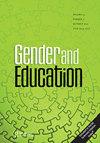Performing feminist research: creative tactics for communicating COVID-19, gender, and higher education research
IF 1.9
3区 教育学
Q2 EDUCATION & EDUCATIONAL RESEARCH
引用次数: 0
Abstract
ABSTRACT Presenting research findings outside of the form of a traditional research report requires different modes of making and communicating. This paper offers an account of how The #FEAS Report, a satirical news video, was made to communicate the findings from interviews and a survey as part of the mixed-methods study, Sexism, Higher Education, and COVID-19: The Australian Perspective to a wider public. Three creative tactics for research communication were used: DIY aesthetics, humour, and situated bodies. These communication tactics enabled the researchers to think differently about what research findings mean, and how to articulate them in ways that are intelligible. The paper shows how these tactics worked to bring findings to audiences beyond the academy and ask audiences within the academy to think differently about research reporting and knowledge communication. The paper considers how performing research in this way generates different conversations that compliment those started by more common ways of presenting research findings, and most importantly, how crucial it is for feminist researchers to make space for the creative within contemporary higher education.开展女权主义研究:传播COVID-19、性别和高等教育研究的创造性策略
在传统的研究报告形式之外呈现研究成果,需要不同的制作和交流模式。本文介绍了如何制作#FEAS报告,这是一个讽刺新闻视频,作为混合方法研究“性别歧视、高等教育和COVID-19:澳大利亚视角”的一部分,将采访和调查的结果传达给更广泛的公众。研究传播使用了三种创造性策略:DIY美学、幽默和情境体。这些交流策略使研究人员能够以不同的方式思考研究结果的含义,以及如何以可理解的方式表达它们。这篇论文展示了这些策略是如何将研究结果带给科学院以外的受众,并要求科学院内部的受众以不同的方式思考研究报告和知识传播的。本文考虑了以这种方式进行研究如何产生不同的对话,以赞美那些以更常见的方式呈现研究结果的对话,最重要的是,女权主义研究人员在当代高等教育中为创造性创造空间是多么重要。
本文章由计算机程序翻译,如有差异,请以英文原文为准。
求助全文
约1分钟内获得全文
求助全文
来源期刊

Gender and Education
EDUCATION & EDUCATIONAL RESEARCH-
CiteScore
5.20
自引率
9.10%
发文量
31
期刊介绍:
Gender and Education grew out of feminist politics and a social justice agenda and is committed to developing multi-disciplinary and critical discussions of gender and education. The journal is particularly interested in the place of gender in relation to other key differences and seeks to further feminist knowledge, philosophies, theory, action and debate. The Editors are actively committed to making the journal an interactive platform that includes global perspectives on education, gender and culture. Submissions to the journal should examine and theorize the interrelated experiences of gendered subjects including women, girls, men, boys, and gender-diverse individuals. Papers should consider how gender shapes and is shaped by other social, cultural, discursive, affective and material dimensions of difference. Gender and Education expects articles to engage in feminist debate, to draw upon a range of theoretical frameworks and to go beyond simple descriptions. Education is interpreted in a broad sense to cover both formal and informal aspects, including pre-school, primary, and secondary education; families and youth cultures inside and outside schools; adult, community, further and higher education; vocational education and training; media education; and parental education.
 求助内容:
求助内容: 应助结果提醒方式:
应助结果提醒方式:


